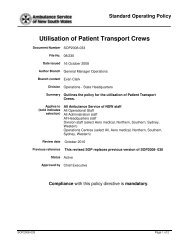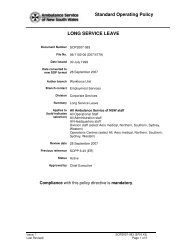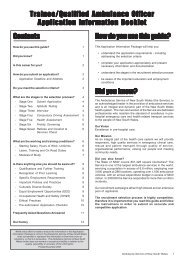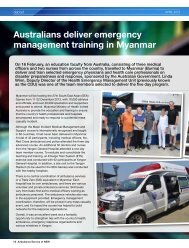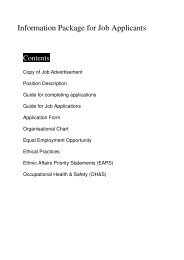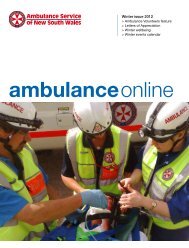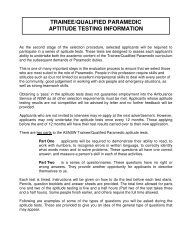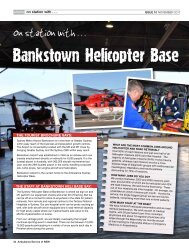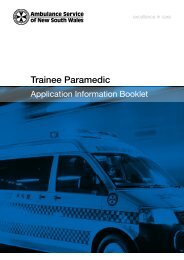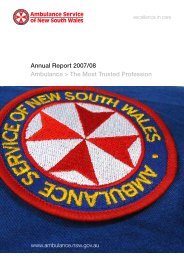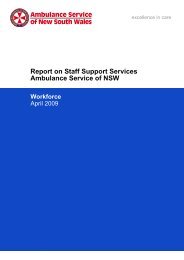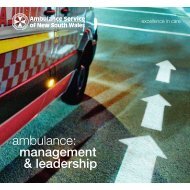atsb final report released 16 may 2013 - Ambulance Service of NSW
atsb final report released 16 may 2013 - Ambulance Service of NSW
atsb final report released 16 may 2013 - Ambulance Service of NSW
Create successful ePaper yourself
Turn your PDF publications into a flip-book with our unique Google optimized e-Paper software.
FINDINGSFrom the evidence available, the following findings are made with respect to thewinching accident that occurred <strong>16</strong> km west-south-west <strong>of</strong> Wollongong Airport,New South Wales on 24 December 2011 and involved Agusta WestlandAW139 helicopter, registered VH-SYZ. They should not be read as apportioningblame or liability to any particular organisation or individual.Contributing safety factors• The low light conditions prevented the air crewman from seeing the winchcable, affecting his assessment <strong>of</strong> the potential effect <strong>of</strong> the upwards movement<strong>of</strong> the helicopter while winching in the cable, and led to the patient and dutyparamedic being unintentionally pulled from the ledge.• The position <strong>of</strong> the helicopter at the time the patient and duty paramedic werepulled from the ledge, although necessary to ensure adequate hover reference inthe low light conditions, made their contact with the ground unavoidable, andresulted in the fatal injuries sustained by the duty paramedic.• The continued execution <strong>of</strong> the retrieval plan in dark conditions contributed tothe air crewman’s misperception <strong>of</strong> the amount <strong>of</strong> slack in the winch cable, andthe extent that the helicopter was displaced from the rock ledge.• The accepted use <strong>of</strong> procedural adaptation by special casualty access teamparamedics, and the past success <strong>of</strong> rescues that involved adapted techniques,probably led to the retrieval procedure that was used on the night. [Minor safetyissue]Other safety factors• The air crewman was unable to communicate with the paramedics via radio dueto a lack <strong>of</strong> familiarity with the helicopter’s radio system.• The planned retrieval procedure, utilising a stabilising rope system, was neitherdocumented nor trained for and the crew’s resulting low level <strong>of</strong> familiaritymade assessment <strong>of</strong> the associated risk difficult.• <strong>Ambulance</strong> rescue crewmen did not conduct any night winching recencytraining, resulting in an increased risk <strong>of</strong> unfamiliarity with night winchingprocedures and their associated hazards. [Minor safety issue]• The increased capability <strong>of</strong> helicopters and rescue winches enabled the conduct<strong>of</strong> complex winch rescues beyond the current level <strong>of</strong> winch training andprocedural support associated with the traditional special casualty access teamclinical access role, leading to an increased risk that hazards associated withcomplex rescues were not identified. [Minor safety issue]• The helicopter’s lighting set-up did not allow independent control <strong>of</strong> thesearchlights by the pilot using the switches on the flight controls, as required bythe operations manual and Civil Aviation Order 29.11, and increased the risk <strong>of</strong>the loss <strong>of</strong> hover reference and distraction in the case <strong>of</strong> a single light failure orswitch mis-selecion by a pilot. [Minor safety issue]- 45 -



